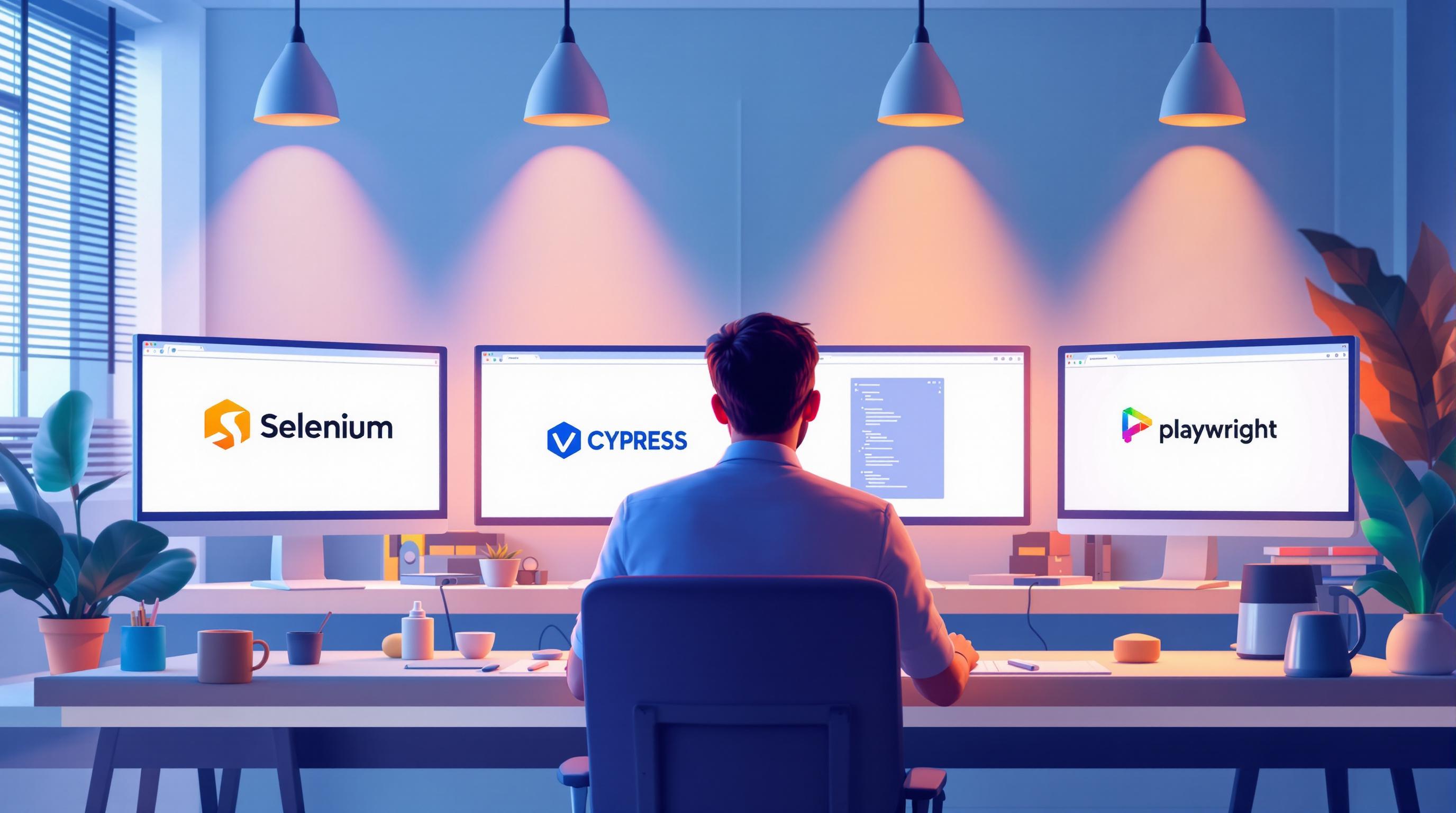Struggling to find the right AI testing tool? Here's a quick 5-step guide to help you make the best choice:
- Identify Your Needs: Define your testing goals (e.g., functional, regression, performance) and assess your app's complexity, update frequency, and integration requirements.
- Evaluate Features: Look for AI-powered capabilities like self-healing automation, test case generation, and predictive analytics. Ensure the tool supports web, mobile, API, and performance testing.
- Check Compatibility: Ensure seamless integration with your CI/CD pipeline, team tools, and platforms (e.g., browsers, OS, devices).
- Compare Costs & Support: Understand pricing models (open-source, freemium, enterprise), vendor reliability, and ROI. Factor in training and maintenance costs.
- Test & Compare: Use demos, trials, and reviews to evaluate tools like Testim.io, Functionize, and Tricentis Tosca for usability and performance.
Key takeaway: Focus on tools that align with your testing needs, integrate well with your workflows, and offer long-term value. Test before committing!
10 AI-Powered Software Testing Tools You Have to Know
Step 1: Identify Your Testing Needs
Choosing the right AI testing tool starts with understanding what you need. Clear requirements are key to finding a tool that fits your goals.
Define Your Testing Goals
Think about what you want to achieve with testing. Are you focused on ensuring features work as they should (functional testing), checking updates don't break anything (regression testing), measuring system speed and reliability (performance testing), or identifying security risks? Pinpointing these goals will guide your tool selection.
Assess Application Complexity and Future Changes
The complexity of your application plays a big role in determining the type of tool you need. If your app has frequent updates, multiple integrations, or complex user interactions, you'll want a tool that reduces maintenance. Tools like Testim.io or Testsigma are designed to handle these challenges by speeding up automation for systems that are constantly evolving. Key factors to consider include:
- How often the application is updated
- The number of systems it integrates with
- Patterns of user interaction
- Plans for future growth
Evaluate Integration Requirements
Make sure the tool works well with your current setup. It should integrate smoothly with your CI/CD pipeline (e.g., Jenkins), project management tools (e.g., Jira), and testing environments. Look for tools with strong APIs or built-in integrations to streamline your workflow and avoid unnecessary complications.
Once you’ve nailed down your testing needs, you’ll be ready to explore the features of different AI testing tools and see how they match up with your requirements.
Step 2: Review AI Tool Features
Once you've defined your testing requirements, the next step is to examine the features offered by AI testing tools. Today's AI-driven testing solutions come with advanced capabilities designed to boost efficiency and reduce manual effort.
Focus on AI-Powered Features
AI tools such as Testim leverage machine learning to streamline processes like self-healing automation and automatic test case creation. These features save time for agile teams by minimizing test maintenance.
"Testim uses AI to generate, execute, and maintain test cases, making it ideal for agile development teams that need to move quickly while maintaining quality standards." [1]
Here are some key AI features to consider:
- Self-healing automation: Automatically adjusts to changes in the user interface.
- Visual testing: Detects UI inconsistencies with AI-driven precision.
- Test case generation: Creates test scenarios automatically, reducing setup time.
- Predictive analytics: Flags potential failure points early in the process.
Look for Comprehensive Testing Support
Your chosen tool should accommodate various testing types - web, mobile, API, and performance testing - within a single platform. Key capabilities to look for include:
- Web application testing across multiple browsers.
- Mobile testing for Android and iOS platforms.
- API testing functionality.
- Support for desktop application testing.
- Performance and load testing features.
Evaluate Scalability
Scalability is critical, especially for enterprise-level testing. Tools like Tricentis Tosca are designed to handle large and complex test loads without sacrificing speed or reliability. When assessing scalability, consider:
- Test execution and resource management: Efficiently manages simultaneous tests and resources.
- Integration flexibility: Adapts to diverse environments and workflows.
- Performance under load: Maintains speed and accuracy as test suites grow.
For example, Testsigma can scale effortlessly, increasing automation speed by up to five times while ensuring consistent results. Once you've reviewed these features, the next step is to confirm the tool's compatibility with your current workflows.
Step 3: Check Integration and Compatibility
After evaluating AI features in Step 2, it's time to ensure that the tool integrates smoothly with your current systems. This step is essential for effective testing and maintaining workflow efficiency.
Confirm CI/CD Integration
Your AI testing tools should work effortlessly within your CI/CD pipeline. This allows for continuous testing and fast feedback loops. Look for features like:
- Automated test triggers when code changes
- Instant reporting of results
- Deployment gates you can configure
- Real-time notifications for failures
These capabilities help streamline the testing process and ensure quick responses to issues.
Verify Compatibility with Team Tools
The tool should work well with the platforms your team already uses, such as issue trackers, communication apps, and code repositories. For example, Testim integrates with various team tools, helping maintain smooth workflows and boosting overall productivity.
Ensure Platform and Browser Support
To cover all testing scenarios, the tool must support multiple platforms and environments. Key areas to check include:
- Popular web browsers like Chrome, Firefox, Safari, and Edge
- Mobile operating systems such as iOS and Android
- Desktop OS compatibility
- Testing across different screen sizes and resolutions
For instance, Test.ai uses machine learning to adapt to a variety of testing environments, while enterprise-focused tools like Sauce Labs offer extensive platform coverage to ensure consistent quality across devices and systems.
Once you've confirmed integration and compatibility, the next step is to explore costs and support options to ensure the tool fits your long-term needs.
sbb-itb-cbd254e
Step 4: Compare Costs and Support Options
Now that you’ve outlined your testing needs and identified the must-have features, it’s time to dive into the financial and support aspects. These factors play a key role in ensuring you choose a tool that works for the long haul.
Understand Pricing Models
Testing tools come with different pricing structures. Here’s a quick breakdown:
| Pricing Model | Features | Best For |
|---|---|---|
| Open-source | Free with community-driven updates, basic support | Small teams with tight budgets |
| Freemium | Free basic features, paid upgrades for advanced tools | Teams experimenting or scaling up |
| Enterprise | Full access to features, dedicated support | Large organizations with complex needs |
Costs can range from free open-source options to enterprise tools that charge thousands each month. Pick a model that fits your budget and testing requirements.
Research Vendor Reliability
When selecting a vendor, reliability matters. Here’s what to look for:
- Active user forums and frequent updates: Tools with active communities and regular updates are more likely to stay relevant.
- Round-the-clock support: Ensure the vendor offers 24/7 assistance, especially for critical projects.
- Customer reviews and case studies: Check platforms like Gartner for verified reviews and look for case studies that prove consistent performance.
- Support contracts: Explore options for long-term support agreements to secure ongoing assistance.
Analyze Return on Investment
AI-powered tools can speed up automation by up to 5x and improve efficiency for 80% of teams [3][5]. To evaluate ROI, think about:
- Direct cost savings
- Higher software quality
- Better resource allocation
- Faster release cycles
For example, Testim.io simplifies test creation, cutting down on maintenance time, while Functionize uses deep learning to improve execution efficiency [4].
Don’t forget to account for additional costs like training, integration, maintenance, and infrastructure. Compare these expenses against the potential benefits to gauge the long-term value of the tool.
Once you’ve assessed costs and support, you’re ready for the final step: hands-on testing and gathering user feedback to make your choice.
Step 5: Compare and Test Tools
Now that you've identified your testing needs, required features, and budget, it's time to put your options to the test through comparisons and hands-on evaluations.
Research with Directories
Directories like testingtools.ai are a great starting point for comparing AI testing tools. Focus on criteria such as AI capabilities, supported testing types, and pricing structures. Choose tools that align closely with the priorities you outlined in Step 1. For example, if web testing is a major requirement, platforms like Testim.io and Functionize offer AI-powered features tailored for this purpose.
Check User Reviews and Case Studies
Before making a decision, dive into user reviews and case studies to see how these tools perform in real-world situations. Platforms like Gartner provide verified feedback that can reveal potential integration issues, time savings, and customer support quality. For instance, Tricentis Tosca showcases its capabilities through detailed case studies, highlighting successful integrations across web, mobile, and API testing environments.
Try Demos or Free Trials
The best way to evaluate a tool is to test it yourself. Many AI testing tools offer free trials or demos, allowing you to see how they handle real-world scenarios. Use this opportunity to assess features like test creation, maintenance, and compatibility with your workflows. Involve your team to gather input on usability and performance.
For instance, Sauce Labs provides free trials that allow teams to fully explore their AI-driven testing features under practical conditions. Document your findings and collect feedback from your team to make an informed choice.
Conclusion: Choose the Right Tool for Your Needs
Picking the right AI testing tool is a decision that can directly improve your testing efficiency and the quality of your software. With the 5-step evaluation process outlined here, you now have a clear method to choose a tool that matches your organization's needs.
AI-driven platforms like Testsigma show how automation can help testing teams save time and resources. Every step in this guide - from assessing your needs to trying out tools - helps you make a well-informed choice tailored to your goals.
When deciding, focus on tools that offer essential AI features, fit smoothly into your workflows, and grow with your demands. Look at the return on investment (ROI) by considering factors like time saved, resource efficiency, and better software outcomes.
Modern solutions like SeaLights provide advanced features such as test optimization, which can greatly improve testing productivity [4]. While comparing costs, think about the long-term benefits and ROI instead of just the upfront expense.
Take advantage of demos and trials from top tools like Testim.io and Functionize to ensure they meet your team's requirements [4]. By following this structured process, you’ll be prepared to pick a tool that streamlines your testing and supports long-term success.
FAQs
How to select a tool for automation testing?
Choosing the right automation testing tool depends on your project's specific needs, such as the complexity of your application, integration requirements, and overall testing objectives. For instance, Test.ai is a strong option for handling functional and regression testing in more complex applications [1].
It's also important to ensure the tool integrates well with your current tech stack. Tools like Testim are designed to work smoothly with popular CI/CD platforms like Jenkins and GitHub Actions, making automated testing workflows more efficient [1][2].
If your team needs advanced AI-driven features, consider tools like Keysight Eggplant Test. It offers AI-powered test generation, automatic test updates, and predictive analytics. These features can help spot issues early and simplify test maintenance, saving time and resources [1].
When evaluating costs, don't just look at upfront pricing. Factor in long-term expenses such as:
- Training for your team
- Ongoing maintenance
- Scalability for future needs
- Return on investment over time [2]



